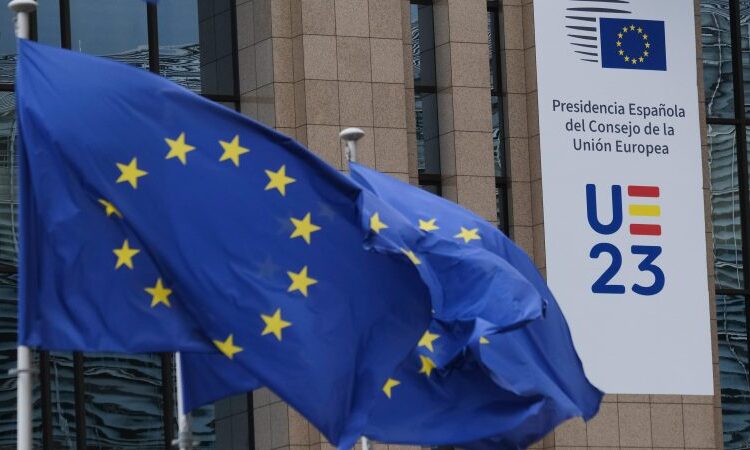
EU countries are in a deadlock over reforming the bloc’s electricity market, something the Spanish EU Council Presidency is looking to solve as national elections loom on 23 July.
The electricity market reform, tabled by the European Commission in March, seeks to avoid a repeat of last year’s energy crisis, which saw consumers faced with soaring energy bills due to record-high gas prices.
However, finding a reform that works for the different energy mixes and economies of all 27 countries has proven difficult, with talks failing to come to fruition by the end of June.
“There is more time needed to find a text which works for everybody,” an EU diplomat told EURACTIV following a meeting of EU ambassadors on 30 June that ended without agreement.
Now lawmakers in the European Parliament have reached a political deal on the reform, which still needs to be confirmed by a vote on 19 July in the assembly’s industry committee.
Meanwhile, the Spanish EU Council Presidency, which took the baton from Sweden on 1 July, is attempting to find a deal “at the earliest possible date”, according to a second EU diplomat. Ministers will meet in Spain from 10 to 12 July to discuss ongoing energy and environment topics, including the reform.
Options
The EU’s 27 energy ministers were meant to agree on the reform on 19 June but hit a stumbling block when they disagreed on government support for coal-fired power generation and the lifetime extension of existing nuclear plants.
According to a document circulated by the Spanish Presidency, these “points of contention” remain unsolved. The document, seen by EURACTIV, is dated 3 July and was sent before a working group meeting on 6 July.
Probably the biggest issue relates to contracts for difference (CfDs), which allow governments to support energy investments by guaranteeing a minimum revenue to power generators.
The European Commission’s proposal made these contracts mandatory for any new public investment in power generation facilities.
However, there are tensions regarding public investments in the lifetime extension of existing nuclear power plants, with countries like Luxembourg and Germany warning this risks distorting the EU’s internal market.
The document contains possible solutions, including limiting the “proportionate volume” of electricity that a CfD can cover for existing assets. Once this is set, the strike price could be set at a level that would allow an efficient investment recovery.
According to the Spanish Presidency document, the “proportionate volume” of total electricity supported could be determined in three ways:
- “Gross investment: The volume of electricity under a CfD is proportional to the ratio between the new investment and the present value (adjusted for inflation) of the initial gross investment value of the asset.
- Cost of new build: The volume is proportional to the ratio between the new investment and the total investment cost of building a similar asset (same technology) today.
- Incremental lifetime: The volume is proportional to the ratio between the years increase in lifetime of the asset and the original lifetime of the asset when it was built.”
Another solution floated by Madrid would be to ensure the distribution of the revenues preserves the level playing field between EU member states.
This would be done “by limiting the amount of revenues that arise from the settlement of CfDs (related to life extensions) that can be distributed to final electricity consumers including undertakings,” according to the text.
Including coal in capacity mechanisms
The other issue relates to state subsidies for coal power plants that remain on standby as backups to the power grid.
These so-called capacity mechanisms are of particular concern to countries like Poland, which rely on coal for most of their power output, but have raised concerns from green-minded countries like Spain, Luxembourg, and Germany.
“A capacity market for coal power plants is, from Germany’s point of view, not in line with EU climate targets,” said the country’s vice-chancellor and climate minister, Robert Habeck.
“It’s not that coal power plants should not run – that is, of course, necessary as long as we need them, this counts as well for Germany – but to give an extra subsidy system for coal power plants, I think, is too, far-reaching and not aligned with the goals we have agreed on,” he added.
To reach a compromise, there should be a balance between security of supply concerns following the energy crisis and the need to reach Europe’s climate targets, according to the text circulated by the Spanish Presidency.
“In that regard, different conditions could be included as a requisite to defer the emission thresholds applied to power plants under capacity mechanisms,” the text reads, without elaborating on how this could work.
The latest reform of EU capacity markets agreed in 2018 placed a limit on coal subsidies by introducing a CO2 emissions performance standard of 550g per kilowatt hour on all new electricity plants.
The new standard will apply as of 1 July 2025 for existing power plants, with a “grandfathering clause” for capacity contracts concluded before 31 December 2019.
The EU’s 27 energy ministers will gather in Spain on 11-12 July for an informal meeting. Ministers are likely to hold talks about the reform on the sidelines.
[Edited by Frédéric Simon/Zoran Radosavljevic]








